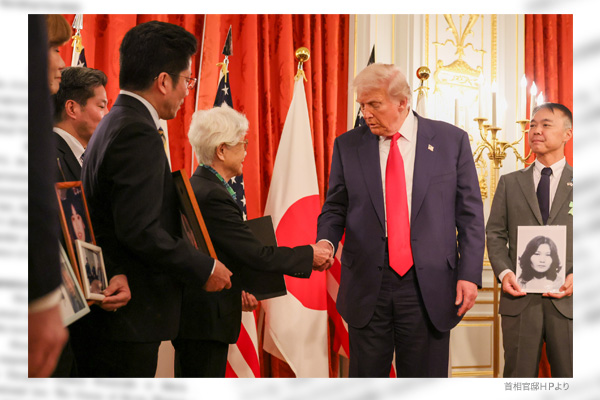On October 28, family members of victims abducted by North Korea met with U.S. President Donald Trump during his visit to Japan. Participating in the meeting were 14 members of nine families, including abduction victim Megumi Yokota's mother, Sakie, her younger brother and leader of the family association, Takuya Yokota, and victim Yaeko Taguchi’s son and secretary general of the association, Koichiro Iizuka. I joined them as chair of a supporting organization.
Japan-U.S. cooperation revived for victims’ return
The family members had initially been set to meet with U.S. Secretary of State Marco Rubio, rather than Trump. When we were in a waiting room, however, government officials told us that the president would come for a photo session at the outset of the meeting. At 11:45 a.m., Trump appeared in front of us, guided by Japanese Prime Minister Sanae Takaichi. After the photo session, President Trump said in front of reporters:
“[The abduction issue] continues for so many years… I'm with [the family members] all the way… We'll be discussing [the abduction issue with North Korean leader Kim Jong Un] … We always have this in mind because it started with [the late former Japanese Prime Minister] Shinzo Abe… We will do everything within our power.”
Later, Trump left the venue while exchanging words with Sakie Yokota, Takuya Yokota, and victim Keiko Arimoto’s sisters (Masako Kitatani and Ikuko Arimoto). There was also a scene where the president saw the signature of a letter from himself to the late Akihiro Arimoto, the father of the sisters, which was framed and brought by the sisters. As Trump described the signature as beautiful and asked who wrote the signature, neighboring Takuya Yokota told him, “It’s yours.” The meeting with Trump lasted for some three minutes, followed by a 22-minute meeting with Rubio.
The framework for Japan-U.S. cooperation in pressing the Kim Jong Un regime to return abductees to Japan, created by the Abe government during the first Trump presidency, has been revived under the Takaichi government. This is very encouraging.
Two days before the meeting, a Jiji Press report from Washington said that Trump was cautious about meeting with the family members, possibly out of consideration for North Korea, which insists the abduction issue has been resolved. Alongside the report, news of Rubio’s planned meeting with the members raised concerns that the Trump administration might be softening its stance of seeking to resolve the abduction issue. However, this concern proved unfounded. While White House Chief of Staff Susie Wiles who oversees Trump’s schedules was reluctant to approve the meeting for the reason that interest in the abduction issue was low in the United States, the president made a final decision to meet, according to informed sources.
Possibility of a U.S.-North Korea summit within this year
The Kim regime aims to invite Trump to Pyongyang. The regime has been conducting thorough research on what Trump likes and dislikes. In this context, Kim has recently shown a sudden eagerness to practice golf with his aides, according to sources. The U.S. and North Korea continue to make contact behind the scenes. On October 29, Trump said he was not able to arrange his meeting with Kim during his current Asian tour. After a short interval, there may be a U.S.-North Korea summit as early as late this year or early next year. It would be the greatest opportunity to resolve the abduction issue.
Tsutomu Nishioka is a senior fellow and a Planning Committee member at the Japan Institute for National Fundamentals and a specially-appointed professor at Reitaku University. He covers South and North Koreas.


